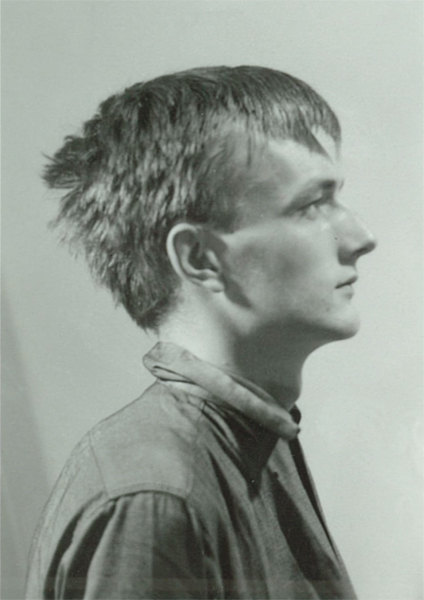Walking, exercising the right to be free
Ralph Rumney

In 1957 lifelong conscientious objector Rumney was one of the co-founders of the London Psychogeographical Association. This organization was, along with COBRA and the Lettrist International, involved in the formation of the Situationist International.
Rumney spent much of his life living as a wanderer, and was variously described as both a ‘recluse’ and a ‘media whore’, seeing his existence as a ‘permanent adventure and endless experiment.’ He moved, as his friend Guy Atkins said, “between penury and almost absurd affluence. One visited him in a squalid room in London’s Neal Street, in a house shared with near down-and-outs. Next, one would find him in Harry’s Bar in Venice, or at a Max Ernst opening in Paris. He seemed to take poverty with more equanimity than riches.”

The Situationist International was founded in the 1950s in France as a group of anti-capitalism intellectuals. The group was working on philosophy and art as a permanent questioning of society and its circumstances. Member of the S.I were the French philosopher Guy Débord (one of the founding member), the British artist Ralph Rumney (also one of the founding member), the Danish artist Asgar Jorn, Raoul Vaneigem, the German artist Lothar Fischer, Constant Nieuwenhuys and Giuseppe Pinot-Gallizio.
Some of their main concepts were based on Guy Débords “The society of the spectacle”, e.g. the counter-technique “détournement” or the wandering around in urban space, called dérive. Ralph Rumney came up with the idea to form the “Psychogeographical Society”, a method to critisize urban structures, by exploring them intensively. The S.I. was intending to cause a revolution in society and in the field of the arts.
The name is based on their belief that everybody could change the world by constructing daily playful situations- in practice, that meant reinventing something existing, e.g. a football game. Danish artist Asgar Jorn invented the three sided football, which is played with three teams instead of the usual two teams.
Psychogeography is…
“The study of specific effects of the geographical environment, consciously organised or not, on the emotions and behaviour of individuals.”
(Preliminary Problems in Constructing a Situation in Situationniste Internationale No.1 1958)
Ralph Rumney once said about the S.I.:”At the level of ideas, I don’t think we came up with anything which did not already exist. Collectively, we created a synthesis, using Rimbaud, Lautréamont and others, like Feuerbach, Hegel, Marx, the Futurists, Dada, the Surrealists. We knew how to put all that together.”
 The Situationist International haven´t been a big happy artist family though-the exact opposite- at the end in 1972 there were only 2 of the once 70 members left– Gianfranco Sanguinetti and Guy Debord. In the course of the time the organisation fell apart. Some members like Ralf Rumney were blamed for actually selling their art, which was understood as a capitalistic act.
The Situationist International haven´t been a big happy artist family though-the exact opposite- at the end in 1972 there were only 2 of the once 70 members left– Gianfranco Sanguinetti and Guy Debord. In the course of the time the organisation fell apart. Some members like Ralf Rumney were blamed for actually selling their art, which was understood as a capitalistic act.
The de-facto leader Débord was also really critical about the admisson of new members. Having many members, being popular and becoming a ideology was exactly what Débord was afraid of and dennounced in his essay “The society of the spectacle”. Débords reinterpreation of the idea of art included that art is not a part of the “life as spectacle”- it should be free from the spectacle.
Débord justified the bootings of some members with the reason that they haven´t been willed to be an artist under the conditions of the revolution of the S.I., which inclueded the reinterpretation of the idea of art.
Even the founding member Ralph Rumney was kicked out of the group because in the eyes of Débord he became a “capitalist” since he sold one of his works to the Guggenheim Museum in New York, which was unfortunatley the Museum of his wifes mother, Peggy Guggenheim. This was a ridiculous approach since Peggy Guggenheim hated his son-in-law her whole life long due to his “unsual” lifestyle. His wife Pegeen Vail Guggenheim was an artist herself. She died tragically in the age of 42 in 1967, because of an overdosis from her medication. Paradoxical Pegeen and Ralphs son Sandro Rumney (grandson of the famous art collector Peggy Guggenheim) is an art-dealer today and manages his grandmother art foundation. Rumney died in 2002. One of his paintings can be seen in the Tate Galery in London.
Walking, exercising the right to be free:
Nevertheless the sacking of the British artist was a huge loss. He wasn´t only one of the founding members of the S.I., but also the motor of the Psychogeographical Society as part of the S.I.
Malcolm Imrie wrote about Ralpf Rumney in The Guardian: ” Rumney embodied the best of the SI (…) in his anger at those who are running, and ruining, this world”.

